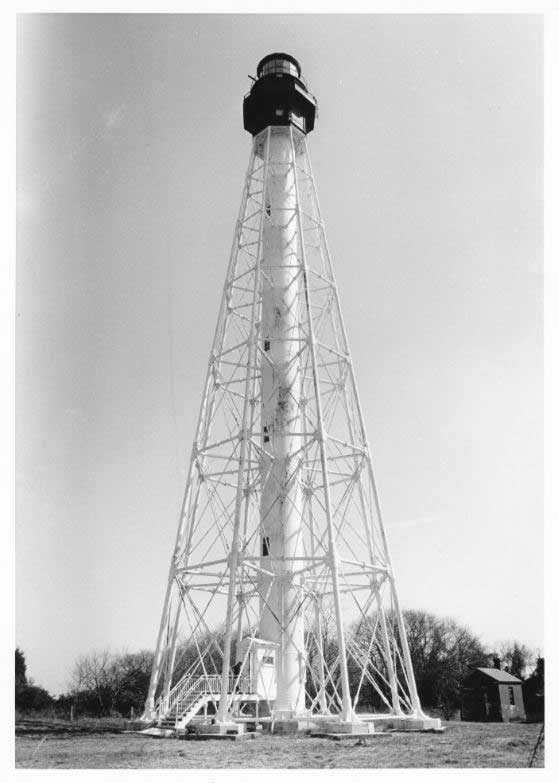The Cape Charles Lighthouse sits at the mouth of the Chesapeake Bay on Smith Island, VA, to mark this important cape. The current Cape Charles Light is the third lighthouse built at this location. At a height of 191 feet, it is the tallest lighthouse in Virginia and the second tallest in the United States.

The first lighthouse at this site was commissioned in 1826 and stood at 55-feet tall. Congress provided $10,000 “for building a light house on Smith’s Island, near Cape Charles,” and a rubblestone tower was erected a year later at a cost of $7399. The tower originally exhibited a flashing light produced by an array of 15 lamps set in 15-inch reflectors, but the lighthouse board soon determined that it should be increased to a First Order light, due to the dangers present at the entrance of the Chesapeake Bay. The light was determined to have a range of no more than 12 miles, and so when the Lighthouse Board assumed control of the country’s navigational aids in 1852, the Cape Charles Light was said to be “requiring the earliest attention” of the department.
In 1856, Congress appropriated $35,000 for rebuilding the lighthouse. While it was being erected, a First-Order Fresnel Lens was installed in the current lighthouse.
The second Cape Charles Light was not completed by the outbreak of the Civil War. Confederates removed the Fresnel light in the original lighthouse, and the light under construction was looted of supplies and materials. A lightship was anchored offshore to mark the entrance to the Chesapeake Bay until the Union could reestablish the light at Cape Charles. An additional $20,000 was provided by Congress in 1864 to complete the new tower.
Once complete, the second lighthouse stood at a height of 150-feet tall. It was made of brick and painted white with a dark brown lantern room. Later, a 25-foot red band was painted around the middle of the tower to make it more visible during the day. It was located about a mile southwest from the old tower, 600 feet from the shoreline.
According to Lighthouse Friends, the second tower was essentially doomed the moment its site was selected. The beachfront of Smith Island, VA, was disappearing at a rate of almost 30 feet per year, and by 1883 it was in serious trouble.
In 1885 Congress granted a request by the board to build protective jetties around the lighthouse, and work commenced in 1886. The contractor requested a year to build protective jetties along the beach, but just a few years later much of the jetty was washed away due to high tides and strong gales. After a particularly strong gale in 1889 washed away more of the jetty and completely surrounded the station with water, the Lighthouse Board came to the conclusion that it would be more economical to build a new station rather than try and save the existing one.
Erosion protective measures were put in place to protect the old lighthouse while a third was being constructed. The jetties were completed in 1891, and a year later land was obtained for the new tower. A bid of $78,200 was accepted to build skeletal towers at both Cape Charles and Hog Island. This design would be cheaper than the Cape Henry model of lighthouse, less susceptible to strong winds, and would look distinct enough from the nearby Cape Henry Light that the two would not be mistaken for each other. The third tower was built in a low and inaccessible marshy region, three-quarters of a mile from its predecessor, so a long wharf had to be built to reach water deep enough to permit boat access.
The Board noted that “the scourge of the mosquitoes, sand flies, fleas, etc… render existence almost unbearable for nearly half the year,” and promised that every effort had “been made in the design of the station to mitigate the undesirable conditions…”
The station’s lens was installed in 1895. The light was automated in 1963, and its Fresnel Lens was removed and donated to the Mariners’ Museum in Newport News, VA. The second Cape Charles Lighthouse succumbed to erosion and toppled into the ocean in July of 1927.
History courtesy of lighthousefriends.com, cheslights.org, and The United States Lighthouse Society.